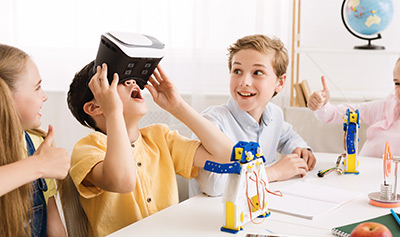The use of augmented reality (AR) in education is increasing in schools globally. Employing augmented reality, schools and colleges are able to engage students in studies and make learning fun and better. AR has many advantages as compared to virtual reality (VR).
Ignitepad believes, by lacing teaching methods with augmented reality we can enhance the abilities of learners such as collaboration, problem-solving, and creation for their holistic development. For example, an AR app can come in handy for kids to color while sketching. Exposure to augmented reality at an early age also increases their technical knowledge along with proficiencies.
For the uninitiated, AR is in its initial stage in most fields especially in education whereas VR has gained momentum. However, AR offers more cost-effective options to institutes with tighter budgets. AR offers the same features and benefits as VR.
The Benefits of AR in Education
AR maximizes learners’ ability to imbibe lessons better while reducing the time spent on knowing about the usage of new technology or solution. AR is also believed to inspire empathy in learners. It is better in the sense that it provides two-dimensional means of conveying information vis-à-vis traditional methods that have one dimension. It is good for online courses. This amalgamation of engagement and interactivity with emotion enhances the student’s power to retain what they have learned. AR results in the quicker acquisition of skills and information.
AR presents students with chances to intensify their acquisition of knowledge in several aspects of education, like:
- Better their reading ability (Spoken English classes and Public Speaking online classes)
- Improved working with numbers (coding classes)
- Clarity on spatial concepts (Python classes)
- Fun-filled and informative playing (piano classes)
- Easy content creation (online courses on digital marketing)
- A better comprehension of real-life scenarios (online courses yoga)
- Enriched experience during field trips and training; relevant to all professions (online music classes for kids)
When it comes to working on assignments that include teamwork, AR easily presents fresh opportunities for learners to develop skills to communicate better or conveniently collaborate with each other. The best part is that potentially they could end up using the same innovation and AR technologies at the workplace during later stages of life.
Adoption of AR is easier as it does not require a full syllabus overhaul. AR can give better and effective results by supplementing the current pedagogical study materials, for instance, it can come in handy in a digital marketing course. It will complement the curriculum by including contextual and relatable practical experiences. AR acts better and provides desired results if used to stimulate enhanced interest in learners and improve discussions on various subjects. AR can find it's base in-class activities.
Requirements for a basic AR setup for learning in a classroom:
- An Internet connection
- Digital smart devices
- AR applications and custom solutions
- Triggering objects that trigger a command taking place on the device screen with the use of the AR app
5 Uses of AR in remote learning
- Classroom infotainment gaming
- Virtual exploration of a physical space
- To facilitate practical tasks
- In overcoming language barriers
- In Special learning
Also, Read:
The importance of co-curricular activities in the growth of a child
Amazing Ways Parents Can Play a Major Role in the Education of Their Children


